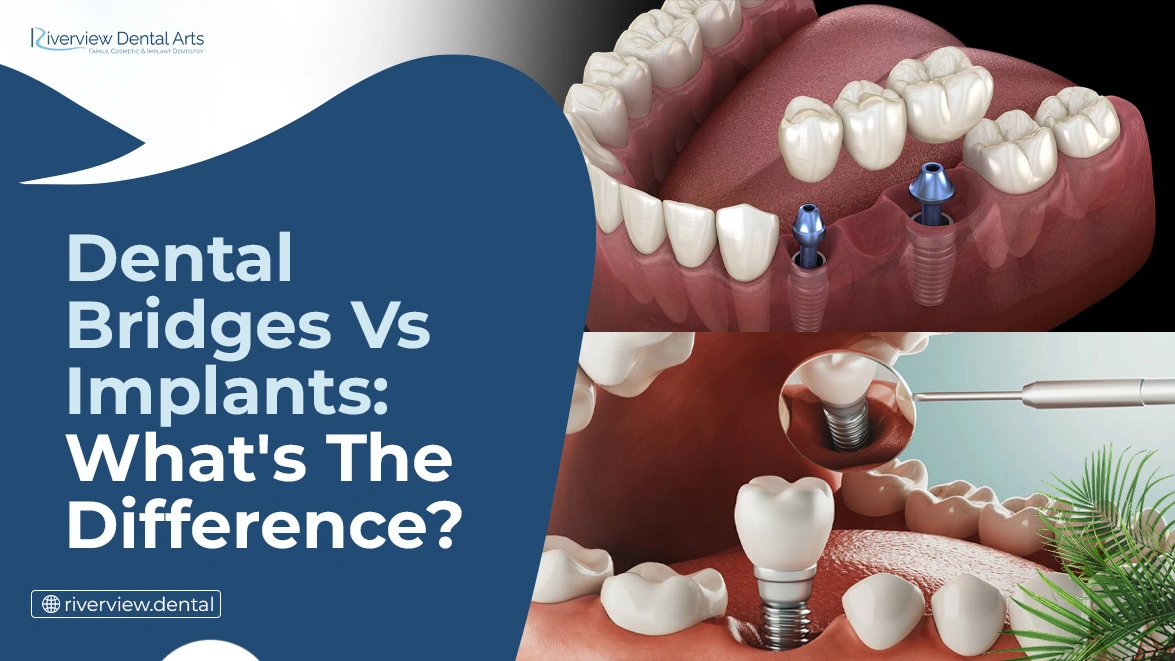Last Updated on October 1, 2025
Replacing missing teeth can be done in several ways, but the two most common treatments are dental bridges and dental implants. A bridge anchors an artificial tooth to the natural teeth beside a gap, providing support and restoring function. On the other hand, an implant uses a titanium post placed into the jawbone to act as a new root, which is then topped with a crown.
Both options restore chewing ability, improve appearance, and help maintain alignment of nearby teeth. Bridges are typically quicker and less costly, while implants offer greater durability and protect bone health. For patients weighing dental bridges vs. implants, it helps to understand how they differ in structure, longevity, and long-term benefits.
What Are Dental Bridges?
Dental bridges are fixed restorations used to replace one or more missing teeth. They work by attaching an artificial tooth, called a pontic, to the natural teeth on either side. These supporting teeth, known as abutments, are usually crowned to hold the bridge securely in place. Bridges restore chewing ability, maintain facial shape, and help prevent nearby teeth from shifting.
Types of dental bridges include:
Here are the types of dental bridges:
- Traditional bridges: supported by crowns on both sides of the gap.
- Cantilever bridges: supported on one side only, used when no adjacent teeth are on one side of the gap.
- Maryland bridges: use a metal or porcelain framework bonded to the backs of adjacent teeth.
- Implant-supported bridges: rely on dental implants instead of natural teeth for support.
Patients who need a quick, cost-effective solution often find bridges to be a practical option. However, they do require reshaping healthy teeth, which is an important consideration.
What Are Dental Implants?
Dental implants are titanium posts surgically placed into the jawbone to act as artificial roots. After healing, a crown is attached to restore both the look and function of a natural tooth. Implants stand independently, meaning they don’t rely on nearby teeth for support.
Types of implant solutions include:
Here are the types of dental implants:
- Single implants: replace a single missing tooth with one implant and crown.
- Implant-supported bridges: replace multiple teeth using implants for stability.
- Implant-supported dentures: provide support for full or partial dentures for better comfort and function.
Implants preserve bone health by stimulating the jawbone and preventing bone resorption. They are also long-lasting, often lasting decades with proper care. While implants may require a longer treatment process and higher upfront cost, many patients prefer them for their durability, natural feel, and ability to protect surrounding teeth.
How Dental Bridges and Dental Implants Differ
Choosing between a bridge and an implant often comes down to more than just replacing a missing tooth. Patients want to know how each option affects long-term oral health, the time involved, and the overall investment. While both treatments restore chewing and appearance, the way they do it is very different. The table below highlights the most important distinctions:
| Factor | Dental Bridges | Dental Implants |
| Support | Anchored to nearby teeth | Anchored into the jawbone |
| Impact on teeth | Requires reshaping of healthy teeth | Surrounding teeth remain untouched |
| Durability | Lasts 10-15 years | Lasts for decades with proper care |
| Bone Health | Does not prevent bone loss | Stimulates the jawbone, prevents bone loss |
| Treatment time | Quicker, generally weeks | Longer, several months of healing |
| Cost | Generally, a lower upfront cost | Higher initial cost, long-term value |
Key Takeaway:
Bridges are often chosen for their speed and lower upfront price, making them appealing for patients who need faster results. However, they require reshaping nearby teeth and typically need replacement after a decade or so. Implants take longer and cost more initially, but they protect the jawbone, leave surrounding teeth untouched, and can last a lifetime.
Conclusion
Choosing between dental bridges and dental implants depends on a patient’s priorities and oral health. Bridges replace missing teeth by relying on nearby teeth for support, offering a faster and often more affordable solution. Implants go deeper, replacing the root with a titanium post and crown that can last for decades. While bridges generally need replacement after 10–15 years and require reshaping healthy teeth, implants preserve bone health and untouched surrounding teeth.
Both approaches restore function, speech, and appearance, though they achieve this differently. At Riverview Dental Arts, we guide patients through the decision-making process, helping them understand the advantages of dental bridges and implants so they can select a solution that feels natural and lasts.

